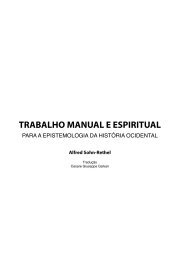Perversion the Social Relation
Perversion the Social Relation
Perversion the Social Relation
- No tags were found...
Create successful ePaper yourself
Turn your PDF publications into a flip-book with our unique Google optimized e-Paper software.
"I Know Well, but All <strong>the</strong> Same ..." 77and so on—to <strong>the</strong> point that she sometimes fears that Throne and Altar,to use Freud's expression, will be endangered if someone suggests disabusing<strong>the</strong> victim. Because of our geneticist preconceptions, we makechildhood a means of diachronic explanation. But, in synchronie perspective,<strong>the</strong> child can, as someone who is both present and an outsider,play a non-negligible role by assuming, as he does among <strong>the</strong> Hopis, <strong>the</strong>burden of our beliefs after disavowal. He is not privy to <strong>the</strong> adults 9 secrets.This may seem to go without saying; but we know well that, in<strong>the</strong> case of certain perverts, it is <strong>the</strong> normal adult who is assumed to becredulous and ignorant of <strong>the</strong> child's secrets. To put it differently, <strong>the</strong>situation is not as natural as it may seem; if psychoanalysis has deliveredus of <strong>the</strong> myth of children's purity and innocence, it has not gone veryfar in analyzing <strong>the</strong> function of this myth. Dazzled by <strong>the</strong> resistance that<strong>the</strong> revelation of infantile sexuality initially provoked, analysts were persuadedthat, by pointing to <strong>the</strong> repression (<strong>the</strong> amnesia) of adults, <strong>the</strong>ywere on <strong>the</strong> vtxf to clearing everything up. But if we admit that invoking<strong>the</strong> ostensible innocence of children is only a way of talking about <strong>the</strong>ircredulity, <strong>the</strong> picture is considerably altered. As with <strong>the</strong> Hopis, if moreconfusedly, infantile credulity helps us disavow our own beliefs: needlessto say, even if we have no direct contact with children, our mental representationof <strong>the</strong>m suffices. Many adults would readily confess—<strong>the</strong>y aresometimes struck by <strong>the</strong> absurdity of <strong>the</strong> situation—that <strong>the</strong>y are religiousnot for <strong>the</strong>ir own sake, but for <strong>the</strong>ir progeny's. This reasonableconcern for children's spiritual education is not <strong>the</strong> whole explanationfor <strong>the</strong> large place that children hold in <strong>the</strong> organization of beliefs. Yetthis concern alerts us to <strong>the</strong> interest that specialists in belief of all kindstake in children, in a way that is somewhat reminiscent of <strong>the</strong> Katcinas',even if <strong>the</strong> social institution that regulates Verleugnung is much less wellorganized in our societies.This very clear-cut example is more a model than anything else: itquite plainly shows how a belief can, if transformed, survive even if itflies in <strong>the</strong> face of reality. It will be readily granted that <strong>the</strong> structureconforms to this model in those cases in which what occurs is ra<strong>the</strong>rwell concealed from <strong>the</strong> consciousness of <strong>the</strong> subject; but, as will soonappear, we also have to admit <strong>the</strong> possibility of o<strong>the</strong>r kinds of structures,not all of which correspond to <strong>the</strong> same model. For <strong>the</strong> moment,let us content ourselves with noting that a belief may be retained without








